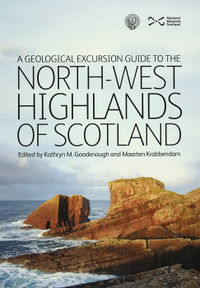Knockan Crag, North-west Highlands - an excursion: Difference between revisions
(Created page with "200px|thumbnail|'''Buy the book''' [https://www.edinburghgeolsoc.org/p_sales.html#nwh '''EGS''']. Also available from Amazon File:EGS_NWH_FIG_047.j...") |
(Created page with "200px|thumbnail|'''Buy the book''' [https://www.edinburghgeolsoc.org/p_sales.html#nwh '''EGS''']. Also available from Amazon File:EGS_NWH_FIG_047.j...") |
(No difference)
| |
Latest revision as of 16:18, 19 December 2015





By Kathryn Goodenough and Maarten Krabbendam
Excursion 6A from: Goodenough, Kathryn M. and Krabbendam, Maartin (Editors) A geological excursion guide to the North-west Highlands of Scotland. Edinburgh : Edinburgh Geological Society in association with NMS Enterprises Limited, 2011.
For key information about this excursion See: Knockan Crag and the Knockan Klippen, North-west Highlands - an excursion
Locality 6.1 Knockan Crag visitor centre and Moine Thrust trail. [NC 188 092]
Park in the Knockan Crag car-park, which has toilet facilities, and follow the waymarked trail to the visitor centre. The trail starts with the ‘Knockan Puzzle’, a wall illustrating all the rock-types of the Assynt region. The puzzle is, of course, how the metamorphosed, Proterozoic Moine psammites have come to lie on top of the younger, unmetamorphosed, Cambro-Ordovician sedimentary rocks. Continue along the trail as it passes through the small SNH visitor centre, which is always open.
The lowest exposures on the trail above the visitor centre are good outcrops of the orange-brown weathering Fucoid Beds Member in a small quarry (See image). Boulders of Pipe Rock are on display here, but the best outcrops of this rock-type occur lower down the slope, in the road cut by the car-park entrance. The Fucoid Beds are followed in upward sequence by thin layers of the Salterella Grit Member, which can be seen where the trail crosses a small bridge. Just above here, in a mossy waterfall, the Fucoid Beds are repeated by a minor thrust.
The trail continues upwards to the Moine Thrust plane, a striking feature at which dark-grey, fractured Moine mylonites rest on top of brecciated, buff-coloured dolostones of the Eilean Dubh Formation (P531955). Steps have been built up to allow visitors to ‘bridge’ the thrust with their hands; continuing a few metres along the trail from this point actually allows access to a better exposure of the thrust. The thrust forms a clear plane, which is inclined towards the south-east at an angle of 8–10˚. A thin breccia, containing fragments of mylonite, occurs along the thrust.
Although the Moine Thrust here at Knockan is a very clear plane, it actually only represents the last part of a complex sequence of deformation. The Moine Thrust was initiated as a ductile structure, which formed the mylonites in the cliff. However, the thrust that is seen here is a later, brittle fault. Evidence for this comes from the intense fracturing of the mylonites and from the presence of breccia, and locally fault gouge, along the thrust plane, which formed during the late-stage movements. The exact nature of the late, brittle movement is rather uncertain. Coward (1985) argued that the brittle movement was related to extensional movement as the thrust pile collapsed. An alternative explanation is that the brittle movement is simply the latest part of progressively colder and shallower level movements in the thrust zone. The ductile and brittle movements at Knockan would all work along the same plane, whereas in the Assynt Culmination the movements were partitioned along different thrust planes. Freeman et al. (1998) have suggested that ductile deformation on the Moine Thrust at Knockan ended at c.430 Ma (latest Llandovery, early Silurian).
Locality 6.2 Viewpoint at top of Knockan Crag. [NC 194 094]
From the thrust plane exposures, follow the trail northwards up onto the top of the crag where mylonites are well-exposed, and take a short spur off to a viewpoint on the left. On a fine day there is a wonderful view from here of the peaks to the west, with Cùl Beag and Cùl Mòr prominent in the foreground and Stac Pollaidh protruding beyond. Canisp and Suilven can also be clearly seen to the north-west. The double unconformity, with pale grey quartzites of the Eriboll Formation overstepping well-layered Torridon Group sandstones which lie on hummocky Lewisian gneisses, can be seen particularly well on the slopes of Cùl Mòr and Canisp.
To the north, the view extends across Cam Loch to the peaks of Conival and Ben More Assynt beyond (P667671). The quartzite-dominated Breabag Dome lies in front of Ben More Assynt. In the foreground, immediately in front of the viewpoint, are peat hags with scattered outcrops of Moine mylonite. Beyond these is a green, grassy knoll with outcrops of pale grey dolostone of the Eilean Dubh Formation. The Moine Thrust runs between these two contrasting areas of ground.
Locality 6.3 Eagle Rock. [NC 188 086]
Continue southwards along the cliff-top path over exposures of finely banded, grey-weathering Moine mylonites. It is worthwhile taking the short detour to Eagle Rock, where particularly good mylonite exposures can be seen in the low cliffs (P512960). With careful examination of faces parallel to the ESE–WNW transport direction, shear-sense indicators can be seen in the mylonites. After studying the outcrops, return from here along the path to the car-park.
References
| At all times follow: The Scottish Access Codeand Code of conduct for geological field work |